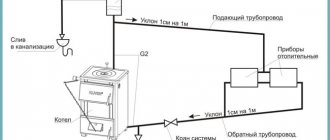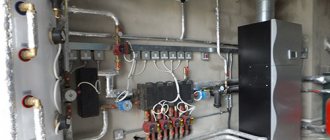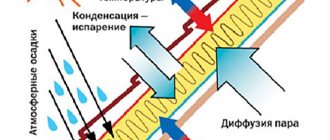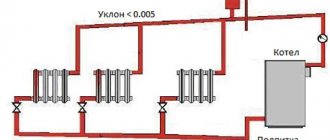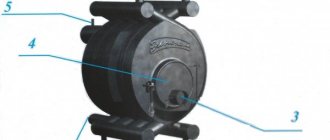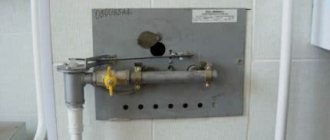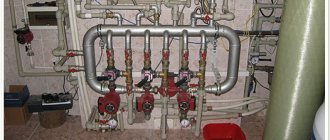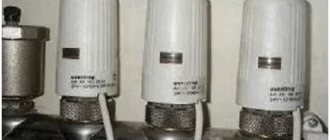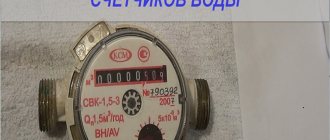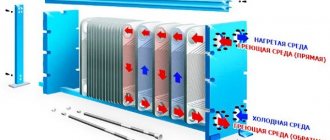Home / Commissioning
Back
Published: 05/19/2019
Reading time: 6 min
0
3831
To understand why an expansion tank is needed, you should familiarize yourself with the operating principle and main functions of such a tank. Without this information, you may mistakenly think that the item is not of particular value and is simply taking up space in the room. However, in practice, it performs a lot of important tasks and is an indispensable component of the heating system.
- 1 Expansion tank in an open system 1.1 Operating principle
- 1.2 Where to place
- 1.3 What tank volume is required
- 2.1 Design and principle of operation
How it works and what it is needed for
As we have already said, a compensation tank is needed for the efficient uninterrupted operation of the heating system. This device collects the liquid that has expanded as a result of heating, preventing accidents and leaks. During cooling, the coolant is evenly distributed throughout the pipes.
In the absence of an expansion tank, the operating pressure will rise to a critical point of 3 atmospheres, as a result of which the emergency valve will be activated and excess liquid will be discharged. In addition to the heating system, the expansion tank is used in hot water supply.
Expansion tank device
After using hot water from the boiler, this device will fill with cold liquid. During heating, it will have nowhere to go and an accident will occur. The compensation tank serves to prevent such accidents. Instead of a tank in a hot water supply system, you can use an emergency valve, but frequent activation of it leads to leaks and damage to the device.
The main functions of the expansion tank are:
- Collection of excess coolant;
- Filling pipes with water when there is a lack of liquid;
- Collection of accumulated air or water vapor that is released as a result of the operation of the heating system;
- Balancing operating pressure by increasing or decreasing the volume of liquid.
Scheme of operation of an expansion tank
At the moment, you can find many different models of compensation tanks on the construction market. All these devices can be divided into two types: open and closed. Despite the external similarity, the installation of these devices is carried out using different technologies.
Note! Open expansion tanks are used less and less; they are ineffective and require constant refilling of coolant. Closed compensation tanks differ from analogues in their compact overall dimensions. Such devices operate without human intervention.
Calculation of expansion tank capacity
When calculating the volume of an expansion tank for heating, you need to take into account the capacity of the system, the location of the intended installation of the tank, permissible hydraulic pressure, and the type of heat supply system (for example, centralized or autonomous, closed or open).
Note! When calculating the volume of the tank, you can use the services of third-party specialists or do it yourself. The easiest way to determine the capacity of a heating system. For example, with a volume of circulated coolant of 400 liters, an expansion tank with a capacity of 40 liters (10 percent of the original volume) is required.
When circulating glycol liquid instead of water in the heat supply system, about 50 percent must be added to the calculated volume of the expansion metal tank. It is also important to consider that when operating a closed heating system, about 3 percent of the coolant is spent on replenishing possible leaks.
To obtain a more accurate calculation, it is recommended to use special software or online calculators. If the tank capacity is correctly calculated, the safety control valve will not operate.
Volume calculation
The process of calculating the volume of open and closed type expansion tanks is somewhat different. The tank for an open heating system is made of sheet metal. The container has a hole for supplying coolant to the system.
Such devices may have another hole, which is located in the upper part and serves to drain excess liquid into the sewer. In some cases, coolant (water) is supplied to the open expansion tank automatically, as it decreases.
When designing a heating system, it is important to calculate the volume of the compensation tank. The main value from which all calculations are based is the total volume of water in the system, for example, 100 liters.
Note! When calculating the volume of an open type expansion tank, a value of 10% is taken in relation to the total amount of coolant in the system. In our case, we need a 10 liter tank.
Expansion tank 10 liters
This calculation system, the so-called folk method, can also be used for closed type compensation tanks. In addition, there is a more accurate method for calculating the volume of the tank. We will need the following data:
- RH – the volume of increase in the coolant when heated. For water this value does not exceed 5%, for antifreeze it is within 6%;
- VK is the total volume of coolant in the heating system circuit. The amount of water can be measured using buckets or using a special meter that is installed on the drain pipe;
- DS - maximum pressure in the circuit and boiler (such information is provided in the instructions for the heating device);
- DB – pressure in the expansion tank.
To accurately calculate the volume of a closed compensation tank, the following formula is used:
V=OV*VK*(DK + 1) / DS – DB
If we compare the result of the volume of the expansion tank calculated using the traditional method with the value obtained from the formula, then the second result will be smaller. If the size of the tank slightly exceeds the required value, correct adjustment is necessary, which will contribute to the efficient operation of the device.
Technical characteristics of expansion tanks
Expansion tanks for both heating and water supply are equipped with a replaceable chamber-type membrane. This means that they exclude contact of liquid with the walls of the tank. If worn or damaged, the membrane can be replaced.
Replacing membranes in expansion tanks is carried out as follows:
- The section of the system on which the tank is located is closed;
- Water is drained from the blocked area;
- The tank is disconnected from the supply pipeline;
- The counterflange is disconnected from the expansion tank;
- The membrane is removed through the resulting hole in the tank;
- The internal cavity of the tank is purged with compressed air;
- A new membrane is installed. If necessary, it is sprinkled with talcum powder. The membrane apron must fit tightly to the tank flange;
- The counterflange is installed in place and secured;
- The gas cushion air is pumped up to the calculated value;
- The tank is connected to the system.
Pressure
Determining the volume of a closed expansion tank is considered important, but not the main aspect of the proper operation of the heating system. This device consists of two parts connected by a rubber gasket. The air and water that are in these two tanks do not come into contact. A nipple is installed in the air tank, through which oxygen is pumped in and the necessary pressure is created.
During the heating process, the liquid fills one of the tank chambers. Provided there is increased pressure in the air tank, the rubber gasket will not be deformed. This leads to the fact that the compensation tank does not perform its functions.
Note! For proper operation of the heating system, the air chamber of the expansion tank is pumped up to a pressure that is 0.2 atmospheres less than the water pressure in the system. Such operations are carried out before coolant is pumped. Through a special nipple, pressure is added or released to a pressure gauge reading of 1.3 atmospheres, at a pressure of 1.5.
The principle of operation of the expansion tank
In a hot water supply system, the pressure of the air chamber of the tank is set 0.2 atmospheres more than the upper level of the pump.
How to choose an expansion tank?
When purchasing, you need to pay attention to some points:
- type of coolant in the system;
- minimum and maximum pressure;
- tank volume exceeding the maximum coolant value;
- type of connection and location of connectors for fasteners.
When purchasing, it is recommended to pay attention to products from trusted manufacturers. Even if the containers are more expensive, this is justified by the quality: high pressure in the expansion tank will not lead to negative consequences in the form of rupture and failure of the system. The warranty period for such products is longer, because manufacturers are responsible for quality and are confident in their products.
Open type plastic heating tank
The standard material for an expansion tank is metal, but such containers often corrode when exposed to air and water. The way out of this situation is to install a plastic tank, for example, a plastic 20-liter canister with a cut bottom, or a plastic bucket.
At the bottom of such a container, a tap is installed on an elastic band, then a piece of hose is secured, which is securely fixed in the metal pipeline.
Where to install the expansion tank?
The location is selected based on the type of device:
- An open view
is installed at the highest point of the house network. If the building is one-story, you can sit in the attic. Such systems are gravity flow, so a wide pipeline diameter is important. The tank should hold about 10% of the water volume. - The closed appearance
is distinguished by the tightness of the device. The optimal installation option is near other equipment. In systems of this type, the expansion tank for heating operates on a non-freezing coolant. The tank must be capable of holding 15% of the total liquid volume.
Installation in a closed heating system
According to experts, such a device can be installed at any point in the heating system, but it is best to attach the expansion tank to the pipeline in front of the circulation pump.
Note! There is an exception to this rule: the tank cannot be installed after the pump or immediately behind the boiler, because excess pressure will accumulate in it.
Expansion tank in a closed heating system
The container can be installed in any position, but the upper location of the air chamber is considered the best option. In this case, the air bubbles will tend to the top. They will not get into the coolant, which will prevent emergency situations even if the gasket is damaged. A special valve is provided to remove accumulated air in a closed heating system.
Note! The ideal option would be to install an expansion tank in front of the heating device, boiler and pump, on the return pipeline (the pressure is stable here).
The device is fixed to the pipe using fittings on the tee, a tap is installed in front of the tank and after. It is necessary for checking and servicing the device before starting the heating system. To determine the serviceability of the container, turn off the tap, turn on the heating and observe the readings of the pressure gauge.
When the arrow reaches one, open the valve and look at the pressure gauge dial. If the tank is working properly, the pressure should drop to 0.2 atmospheres. This is due to the displacement of excess fluid.
During operation of the heating system, cases arise when the volume of the compensation tank is not enough for efficient heating operation. In this case, there is no need to remove the tank and replace it with a larger reservoir. It would be more advisable to install additional capacity.
Connection diagram for an expansion tank in a closed heating system
If the expansion tank is installed in a heating system with natural coolant circulation, then a steam valve is required. The main task of such a device is to relieve excess pressure that occurs when the liquid is heated above the recommended temperatures.
Why is an expansion tank needed in a heating system?
Water heating has been and remains the most popular among us. For this system to work properly, it is necessary to maintain stable pressure in the network. An expansion tank solves this problem
Creating a heating system is expensive, and each element entails new costs. Is an expansion tank mandatory? Perhaps we can do without it? To answer this question, let’s remember the basics of physics. As you know, a heated liquid has a lower density than a cold one. Due to the difference in these values, hydrostatic pressure arises, pushing hot water to the radiators. But a decrease in density leads to an increase in volume. This means that excess coolant is formed in the network, due to which the pressure in the pipes will increase to critical values. Where should we put them? The answer is obvious - into a separate container, namely into the expansion tank. Water or antifreeze remains in it until it cools (and reduces in volume). After this, the liquid returns to the pipeline. It is clear that the expansion tank is a necessary component of the heating system.
Open type heating scheme
What should you pay attention to when choosing it?
First of all, the type of heating system.
There are only two of them. Open (self-flowing)
assumes that the coolant is water circulating through pipelines naturally, without the use of any forcing mechanisms. These systems use tanks without a lid and install them at the highest point of the circuit. Since water from such a container inevitably evaporates, its level must be constantly monitored. If you neglect this, air will accumulate in the pipes, interfering with the operation of heating devices.
Antifreeze cannot be used in open systems, as it will quickly evaporate from the tank
In a closed (autonomous)
heating system there is a pump that encourages the fluid to move. The entire system is sealed, and therefore evaporation of the coolant is excluded. This, in turn, allows you to use not only water, but also antifreeze. Obviously, in such a scheme a closed tank is used.
Design of a closed expansion tank
The mechanism of action of the expansion tank depends on the design features of the membrane installed in it. A device with a membrane in the form of a diaphragm is a steel barrel or a flat rectangular tank divided in half by a rubber partition. Even at the factory, air is pumped into its upper chamber, creating the initial pressure. And after installation on site, coolant flows into the lower part of the tank, setting the flexible membrane in motion. When it rests on the water/antifreeze surface, the system can be started.
During operation, excess heated coolant is discharged into the tank, compressing the air contained in it. This forces the membrane to move into the air chamber, thereby making more room for excess liquid. When the water/antifreeze cools, decreasing in volume, the pressure on the diaphragm decreases and it returns to its initial position. This is how the pressure in the system is regulated.
In tanks with a balloon-type membrane, a rubber container for the coolant is installed, surrounded by air around the perimeter of the tank. When a heated liquid enters, it expands, like an inflated balloon, and returns to its original size when the coolant cools.
Tanks of this kind have two noticeable advantages. Firstly, they allow precise control of the pressure in the system. Secondly, their membranes can be replaced as they wear out, which cannot be said about diaphragm tanks.
Many manufacturers provide their products with a safety valve. It opens and discharges excess water when the pressure in the pipes rises above the permissible level. If the selected model does not have a valve, you should purchase it separately.
You need to know: blue expansion tanks are equipped with food-grade rubber membranes. They are intended for water supply systems. Red ones are used only for heating
Heating system pressure
Closed heating system
Before filling with water, the pressure in the pipes is 1 atm. When pouring coolant, this indicator immediately changes, even if the liquid is still cold. The reason for this is the different arrangement of the system elements: with an increase in height by 1 m, 0.1 atm is added. This effect is called static . They focus on it when designing networks with natural coolant circulation. One of the main advantages of this system is that pressure deviations can be quickly stabilized if they occur.
In a closed system, excess pressure is formed, which occurs when the coolant heats up and expands in the pipes. It can change in different sections of the highway, so it is important to provide stabilizing devices at the project development stage. Otherwise, there is a high risk that the system will fail.
Please note that for autonomous heating systems there is no strictly fixed pressure level. It is calculated individually, based on the technical characteristics of the equipment, the number of floors of the building and other factors. As a rule, the numbers vary in the range from 1.5 to 2.5 atm.
Installation
Usually the expansion tank is placed next to the boiler on the return line to facilitate maintenance. One important point to pay attention to is the direction of the intake valve. If it looks down, this allows the coolant to drain even when the membrane is damaged. This is an obvious advantage. On the other hand, many experts believe that if the valve is directed upward, therefore, the coolant enters from above, which means that the penetration of air into the container, where there should be only liquid, is prevented.
Too frequent operation of the safety valve indicates that the tank volume is incorrectly determined. It is not necessary to replace the container - you can simply connect another one
To avoid sudden changes in pressure, it is best to place the tank in front of the circulation pump. To prevent it from “boiling”, it is connected to the return pipeline. For greater safety, it is advisable to install a pressure gauge and a manual pressure control valve. After installation, it is necessary to check whether the operating pressure of the device corresponds to that required for efficient operation of the heating network. If not, you will have to bleed the air and pump the container until the indicator reaches the desired value.
Common installation mistakes:
— incorrectly determined volume of the expansion tank;
— ill-conceived installation location, in which access to the tank is difficult;
— use of seals not designed for use in water supply systems.
Pressure surges
Pressure surges are a sure sign of a heating system malfunction. Why do they happen and how to solve the problem? Let's look at the main reasons.
The pressure decreases. Turn off the pump and check the static pressure. If it remains the same, then the circulation pumps are faulty. If it continues to fall, there is a leak somewhere in the boiler pipes or heat exchanger. You can find it by turning off various areas. Where the situation returns to normal is where you need to look for damage.
The pressure is rising. Here is a list of the most common reasons:
- The thermostat completely closed the valves and blocked the supply of coolant from the boiler room to reduce the temperature of the heating devices. The solution is obvious - reconfigure the device.
- There is too much coolant in the system. It is necessary to shut off the power line and set up automation.
- The diameter of the pipes is incorrectly selected - they are too narrow, which leads to an increase in pressure. The smaller the diameter, the greater the pressure. At the boiler outlet pipe this indicator should be the largest.
- The power of the circulation pump has been increased or there is a malfunction in it.
- Clogged filters or mud traps interfere with the movement of coolant. These components need to be cleaned.
- There is an air lock in the pipes. She must be found and brought down.
- Somewhere a tap or valve is closed, blocking the movement of the coolant.
